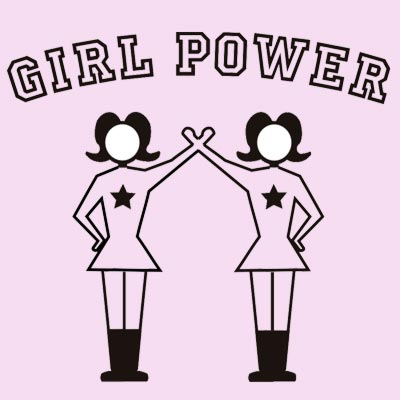Director: Sarah Blout Rosenberg
Year: 2011
Country of Origin: USA
Format: Color, DVD
Running Time: 24 minutes

Girl Power: All Dolled Up takes a fresh look at an age old question: What is girl power and who defines it? Setting the candid responses of multiple young girls (aging from 4-16) against the responses of women in higher academia, Sarah Blout Rosenberg makes visible the crushing effects of popular media and entertainment on the development of a feminine identity.
We are first introduced to the girls sharing what they believe “girl power” is. For Jasmine, 16, “girl power” is about equality: “Females can be powerful and they can do everything males can do.” Karen, 14, takes this a step further, asserting, “girls can do anything guys can do, sometimes they can do it better. And girls can do it differently.” Taina, 12 “girls feeling good about themselves” The younger girls also chime in, seeing “girl power” as standing up for those being bullied or as Taina, 12 sees it “feeling good about themselves.” Sharon Lamb, EdD, Professor at the University of Massachusetts then situates the phrase in a historical context, describing it as emerging in the 70s, a product of second wave feminism that sought to establish that girls could do whatever boys could do. For Carrie Preston, Assistant Professor at Boston University, the continued relevance of “girl power” is reflective of “the desire not to identify as the victim.”
Rosenberg is skeptical, however, of whether this modern-day politics of girl power is even empowering. Uma Thurman in a battle scene in Kill Bill, Angelina Jolie as Lara Croft in Tomb Raider, Ke$ha on a red carpet, Miley Cyrus gyrating in a music video, Katara waterbending in Avatar: The Last Airbender the series, Beyonce shakin it in “Single Ladies,” Superwoman, and finally Lady Gaga scantily clad in “Bad Romance.” Interweaving images of women that seem contradictory- Lara Croft and Ke$ha?- the very notion of what female empowerment is in popular media is scrutinized and the extent to which this new meaning of “girl power” has been co-opted.
Refreshingly, the voices of the young girls, speaking unabashedly about how they interact with media images of themselves, create the narrative. The younger girls giggle and share their desire to look beautiful all the time, how they relish in shopping, and how they want to be Princesses. The older girls, however, offer the most poignant critique: while they understand the “business” of it all, they admit they are still attracted to these products and stereotypes. As the level-headed Karen, 14, lamented: “Every girl wants to find Prince Charming. Every girl wants to have pretty stuff. Every girl wants everyone to love them.” Granted, this response is, as many others in the are, a bit hetero-normative and generalizing. This is Rosenberg’s intention. By layering the voices of an ethnically diverse and wide age-ranging group of young girls, Rosenberg shows that no girl is exempt from these images and that each girl internalizes them.
While Rosenberg touches on the most widely critiqued and established offenders, Mattel (manufacturer of Barbie) and Disney (creator and disseminator of fairy tale stories of Princesses and Prince Charmings), Rosenberg contextualizes her analysis in modern times, considering the impact MGA Entertainment (the manufacturer of Bratz), television programs, entertainment magazines, interactive online games, and musical lyrics have on young girl’s self-perception. In the business of making money, even Dora the Explorer is not Arguably, it is her cutting and fusing of seemingly endless multi-media examples that makes her critique the most powerful: visually, the viewer is constantly bombarded by commercials and magazine covers showing lip gloss, flowing hair and high heels, that he/she undeniably feels the omnipresence and power of these images. In these moments, the viewer departs from being spectator to inhabiting the gaze of a young girl consuming the glitter and glam.
It becomes clear that these brands, only concerned with selling their products, teach girls a very problematic sense of “girl power”, one that claims that beauty, popularity, and approval by men. Girls seeking this sort of disabling empowerment learn another irreversible message: consumption of the right products can grant them happiness. As a scholar in the film put it, the oxymoron of this new sense of “girl power” is that its base, beauty, has nothing to do with “action,” “behavior” or “enacting change” and so thus grants girls a very hollow sense of empowerment.
The documentary ends as it began: revisiting the notion of “girl power” and reinvigorating it. Highlighting female politicians like Michelle Obama and Hillary Clinton, Rosenberg offers an alternative role model than sex vixens like Kim Kardashian and Nicki Minaj. On a somewhat cliche note, the girls then share their aspirations, and how they will use their best asset, their intellect to become: a lawyer, veterinarian, engineer, graphic designer, midwife, teacher, and an artist. In the end, Rosenberg gives the last word to a scholar, who, resisting a polarizing classification of what it means to be an empowered woman provocatively claims “the issue is not that you wear pink or are a cheerleader but that the world acknowledge you are more complex than just that.”
For more information please visit:
http://www.wmm.com/filmcatalog/pages/c817.shtml (Women Make Movies Official Page)
http://www.hghw.org (Hardy Girls, Healthy Women Initiative)
